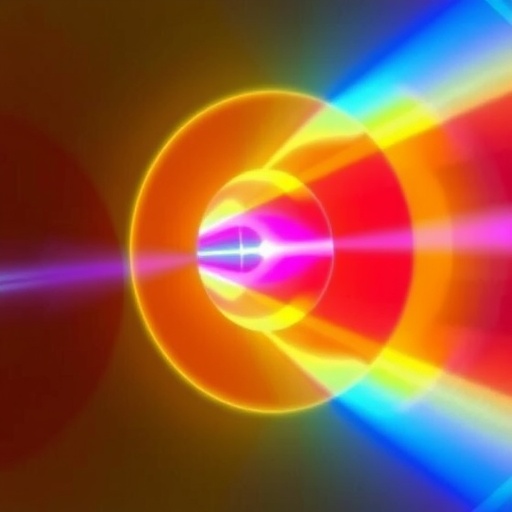In the ever-evolving domain of photodetection technology, a groundbreaking advancement has emerged that promises to redefine the sensitivity and efficiency of mid-wave infrared (MWIR) sensors. Researchers led by Wang, F., Zhu, S., and Chen, W. have unveiled a novel approach centered around bipolar-barrier tunnel heterostructures, a concept that stands to revolutionize how infrared photodetection is achieved and applied across various high-impact fields. This scientific revelation pushes the boundaries of existing semiconductor physics and device engineering, shedding new light on the possibilities of MWIR photodetector design.
Mid-wave infrared detection, typically spanning wavelengths from approximately 3 to 5 micrometers, holds critical importance for applications ranging from environmental monitoring and military surveillance to medical diagnostics and industrial process control. The challenge that has long confronted engineers and scientists is the creation of detectors that not only exhibit heightened sensitivity but also maintain operational stability, room-temperature functionality, and swift response times. Traditional designs have often been marred by trade-offs in noise performance, limited response speed, or complex cooling requirements, preventing their broader deployment.
The research group’s innovative strategy revolves around engineering bipolar-barrier tunnel heterostructures, a sophisticated architecture in which carrier transport is meticulously controlled through the quantum mechanical phenomenon of tunneling across carefully designed heterojunctions. This approach leverages novel material interfaces that construct dual barriers within the device, effectively enhancing carrier separation and minimizing recombination losses, both crucial factors in increasing photodetection efficiency. The structure’s unique bipolar characteristic introduces an asymmetry in the energy barriers for electrons and holes, thereby optimizing the tunneling probabilities and overall device responsivity.
A pivotal advantage of such a bipolar-barrier configuration lies in its ability to significantly suppress dark current— the undesired flow of charge carriers in the absence of incident photons, which is a notorious source of noise detracting from photodetector performance. By incorporating a tunneling mechanism entwined with bipolar barriers, the engineered heterostructure reduces leakage currents while simultaneously allowing rapid photocarrier extraction, steps that culminate in an unprecedented signal-to-noise ratio and detectivity metrics far surpassing those of conventional quantum well or bulk semiconductor detectors.
The design intricacies necessitate precise epitaxial growth techniques to form atomically sharp interfaces among dissimilar semiconductor layers, which may involve complex material systems such as type-II superlattices or narrow bandgap materials tailored for MWIR operation. The interfacial band alignments are carefully tuned to create the desired energy profile that facilitates bipolar barrier formation and controlled tunneling currents. This level of material engineering is indispensable for harnessing the quantum tunneling effect while managing carrier lifetime and mobility within the active regions.
In addition to fundamental emission and absorption physics, the researchers have systematically characterized the temperature dependence of their heterostructure devices, demonstrating that the bipolar-barrier tunnel photodetectors maintain exceptional performance even at elevated temperatures where alternative technologies often falter. This property is particularly significant for practical deployment scenarios where cooling infrastructure is either impractical or cost-prohibitive.
Moreover, the temporal response of these detectors has been scrutinized through ultrafast laser characterization techniques, confirming that the tunneling process and the bipolar barrier architecture jointly confer rapid carrier dynamics essential for real-time imaging and fast data acquisition. Such high-speed operation is a hallmark advancement crucial for integrating MWIR photodetectors into next-generation sensing systems, including those used in autonomous vehicles and advanced threat detection systems.
From a fabrication perspective, the implementation of tunnel heterostructures integrating bipolar barriers aligns well with existing semiconductor manufacturing technologies, hinting at scalability prospects. The ability to produce these devices with relative compatibility to current platforms could catalyze their adoption across commercial sectors without necessitating prohibitively expensive process overhauls.
Beyond detection sensitivity and speed, the bipolar-barrier tunnel heterostructures exhibit robustness in terms of stability and durability over extended operation, as evidenced by rigorous stress tests illustrating minimal degradation in performance metrics. These attributes underscore the technology’s feasibility for harsh environments, from battlefield reconnaissance to spaceborne sensors exposed to extreme conditions.
Of notable interest is the theoretical modeling that underpins the device operation, where computational simulations elucidate the quantum mechanical interactions and potential well profiles underlying the bipolar barriers. Such predictive insights considerably accelerate the optimization cycle, guiding material choices and layer thicknesses toward maximizing tunneling efficiency and minimizing parasitic resistances.
The implications of this research resonate beyond photodetection alone; the principles of bipolar-barrier tunnel heterostructures offer intriguing pathways for advancing other electronic and optoelectronic devices, including tunneling transistors, infrared emitters, and energy conversion units. These cross-disciplinary prospects highlight the broad transformative potential embedded within this novel heterostructure concept.
The work by Wang and colleagues represents a seminal leap in infrared photodetection technology, articulating a device framework that masterfully balances quantum phenomena and material science to surmount longstanding challenges in MWIR sensing. As global demand for high-performance infrared detectors intensifies, innovations like this herald a new era where enhanced sensitivity, temperature resilience, and swift responsiveness become standard features rather than exceptions.
Looking forward, the research community anticipates further refinements and expansions of this approach, potentially exploring integration with two-dimensional materials, nanostructures, or even hybrid photonic systems to amplify the capabilities of bipolar-barrier tunnel photodetectors. Such synergistic advancements promise to unlock unforeseen functionalities and applications, driving the technology onto increasingly interdisciplinary frontiers.
In conclusion, the introduction of bipolar-barrier tunnel heterostructures delineates a transformative route toward ultra-sensitive mid-wave infrared photodetection. By synergizing high-fidelity quantum tunneling control and pioneering material interfaces, this research sets a new benchmark in sensor performance and paves the way for impactful technological breakthroughs across scientific, industrial, and defense landscapes.
Subject of Research: High-sensitivity mid-wave infrared photodetection using bipolar-barrier tunnel heterostructures
Article Title: Bipolar-barrier tunnel heterostructures for high-sensitivity mid-wave infrared photodetection
Article References:
Wang, F., Zhu, S., Chen, W. et al. Bipolar-barrier tunnel heterostructures for high-sensitivity mid-wave infrared photodetection.
Light Sci Appl 14, 246 (2025). https://doi.org/10.1038/s41377-025-01905-y
Image Credits: AI Generated
DOI: https://doi.org/10.1038/s41377-025-01905-y




